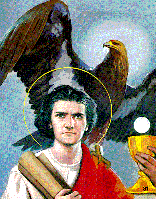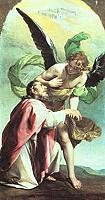|
St.
John the Apostle
 Known as the "beloved Apostle," Saint John, along
with his brother Saint James were personally called by Jesus to become fishers
of men. This had been his avocation before Our Lord touched his life on the
shores of Galilee where he had been born, the son of Zebedee and Salome as
chapter 4 of Matthew and 1 of Mark relate. Known as the "beloved Apostle," Saint John, along
with his brother Saint James were personally called by Jesus to become fishers
of men. This had been his avocation before Our Lord touched his life on the
shores of Galilee where he had been born, the son of Zebedee and Salome as
chapter 4 of Matthew and 1 of Mark relate.
John was the youngest of all the
Apostles and 'dubbed "Sons of Thunder" by Our Lord mainly because of
their volatile temperaments which, in John's case, was greatly calmed once he
began to follow the Messiah. It is no secret, as Sacred Scripture attests to,
that John was a personal favorite of Jesus. The Apostle was handpicked by Our
Lord to accompany Him to the place of the Transfiguration, the healing of
Peter's mother-in-law, the raising of Jairus' daughter from the dead, and the
agony in the garden. John rewarded his Master by being the only Apostle to
follow Jesus to the foot of the Cross. He in turn was rewarded by Our Lord when
He entrusted His most prized possession
into the beloved Apostle's care - His very Own Blessed Mother Mary as the
Apostle relates in his own gospel account, chapter 19:25-27.
John was the first
to reach the empty tomb on Easter morning. After Pentecost, John accompanied
Peter to Samaria to spread the Word to the people there and was present at the
Council of Jerusalem in 49 A.D. After that he traveled to Asia Minor. Some
believe Our Lady accompanied him there and lived in Ephesus, where she died and
was assumed bodily into Heaven.
 Saint Paul affirms in Galatians 2:9 that John,
along with Peter and James, were "these pillars" of the Church.
Church historian Tertullian holds that John traveled to Rome where he
miraculously evaded martyrdom under the vile Roman emperor Domitian, emerging
fresh and cool after being submerged in a boiling cauldron of oil. The Romans
subsequently exiled him to the Isle of Patmos where the Apostle received the
visions he recorded in the Apocalypse/Revelation - the last book of the Bible. Saint Paul affirms in Galatians 2:9 that John,
along with Peter and James, were "these pillars" of the Church.
Church historian Tertullian holds that John traveled to Rome where he
miraculously evaded martyrdom under the vile Roman emperor Domitian, emerging
fresh and cool after being submerged in a boiling cauldron of oil. The Romans
subsequently exiled him to the Isle of Patmos where the Apostle received the
visions he recorded in the Apocalypse/Revelation - the last book of the Bible.
In 96, upon Domitian's death, John returned to Ephesus where he wrote his
gospel along with its three epistles. He has almost always been
depicted with an eagle to signify the soaring of his writings, which were
indeed so brilliant theologically that some came to call him "John the
Divine." John was totally human, however, as we know and he died in
Ephesus around 104. Some historians refute this, claiming John returned to
Patmos where he died just before the turn of the century. Regardless of
accounts, it is fact that John lived a long life and contributed much to
furthering the faith.
|